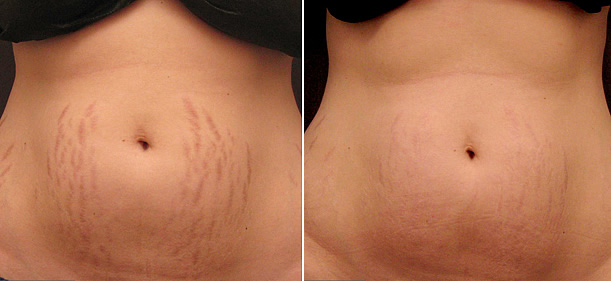Stretch Marks
Stretch Marks
Stretch marks or striae, as they are called in dermatology, are a form of scarring on the skin with an off-color hue. They are caused by tearing of the dermis, and over time can diminish but not disappear completely. Stretch marks are the result of the rapid stretching of the skin associated with rapid growth (common in puberty) or weight gain (e.g. pregnancy) that overcomes the dermal elasticity. Although the skin is usually fairly elastic, when it’s overstretched, the normal production of collagen (the major protein that makes up the connective tissue in your skin) is disrupted. As a result, scars called stretch marks may form.
What are the causes?
Although stretch marks are generally associated with pregnancy and obesity, they can also develop during rapid muscle growth. People who are obese often have stretch marks. Bodybuilders are prone to getting stretch marks because of the rapid body changes that bodybuilding can produce. Stretch marks also may occur if a person uses steroid-containing skin creams or ointments (such as hydrocortisone) for more than a few weeks, or has to take high doses of oral corticosteroids for months or longer.The cause for stretch marks is the hormone glucocorticoid. It prevents the skin cell fibroblast from producing collagen and elastin which are essential to maintain skin health.Between 75% and 90% of women develop stretch marks to some degree during pregnancy. The sustained hormonal levels as a result of pregnancy usually means stretch marks may appear during the sixth or seventh month.
How do they appear
They first appear as reddish lines but tend to gradually fade to a lighter color. Stretch marks occur in the lower skin layer called the dermis, the middle layer that helps the skin retain its shape. No stretch marks will form as long as there is support within the dermis. Stretching plays more of a role in where the marks occur and in what direction they run. But Stretching alone is not the cause. Stretch marks can appear anywhere on the body but are most likely to appear in places where larger amounts of fat are stored. The most common places are the abdomen (especially near the belly button), breasts, upper arms, underarms, thighs (inner and outer), hips, and buttocks.
Are there treatments available?
Although there are tons of creams and other skin products available in the market that claim to eliminate stretch marks, the truth is that most are ineffective and often costly. Regular & gentle peelings and daily scrubbing with a brush can prevent stretch marks, which occur when the skin is stretched during pregnancy or from being overweight. Peelings and washings increase circulation and keep the tissue elastic. The same is true of massages. When stretch marks are already visible on the skin, the use of certain substances such as retinoid creams can help. There are treatments available, particularly with lasers, which can help improve stretch marks, however, no treatment can yet make a stretch mark go all the way back to looking like totally normal skin. We can reduce red stretch marks, diminish white marks, we can improve the texture, and make it look better.
Fractional Laser Treatment and radiofrequency micro-needling can be done for White Stretch Marks. We perform a series of treatments and can get between 60-80% improvements in the appearance of these stretch marks. Generally, we are getting good results with minimal downtime. Patients typically will need 4-5 treatments with this laser procedure for the treatment of stretch marks. Patients can expect improvement in the quality and texture of their stretch marks. However, it is important to note that you cannot fully eradicate stretch marks with any currently available modalities. One thing you can do during pregnancy or times of weight gain is to apply topical moisturizers which help prevent the stretching of the skin.

